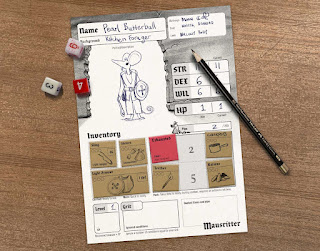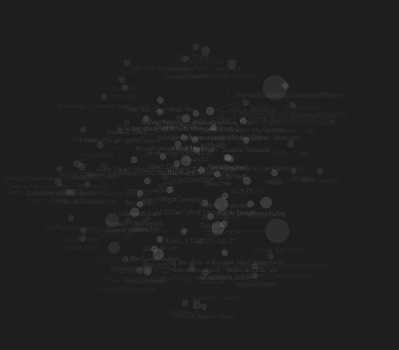3. Sticky note inventory management
Oh boy. Here we go. Another blog post floating about that talks about how they have their own way of dealing with inventory management in TTRPGs. I'm not really adding something new to this ongoing internet conversation but I wanted to show the macaroni art that is my current iteration of inventory management based on my own experiences as a player and gamemaster. Skip to the 6th paragraph onward to see what a sticky note inventory system looks like. There are already a lot of ways that games handle how player characters lug their crap around. This can range to from determining what you can carry by how much they basically would weigh if real, like in DnD 5e, to some sort of slot-based system where the weight of the items is abstracted to some arbitrary unit like in Shadowdark, Knave, or Mausritter (love this one).
 |
| Fig 1. The mausritter system uses physical cards! |
I really like the slot-based based inventory systems because it makes tracking less tedious at the table when you can intuit as gamemaster whether an item would cost a single slot (probably something you can carry in one hand) or more. Players also tend to carry a lot less in slot-based systems, so there is less stuff to manage on their end and the restriction itself leads to interesting choices. Do they keep the golden idol and leave their trusty crowbar behind? As a player I vastly preferred this over weight-based tracking. Virtual tabletop (VTT) character sheets can help mitigate the tedium in those actual weight systems because it does the math for you regarding how much you are carrying. I really like the idea of digital assistants in the future being integrated into in-person TTRPG nights, something I'd like to talk about more in the future.
I currently run and play in a system which uses slot-based inventory management (Worlds Without Number, WWN from here on out) and for the most part I think it works great, though there is one big problem which I would like to address. As a player I find that I am constantly shuffling stuff around especially since WWN divides your inventory into two buckets, essentially what is on your immediate person and what is in your backpack. This fluctuating inventory system means that I am writing down and erasing items with some frequency which I find particularly tedious and makes it less likely that I engage with my inventory or anyone else's inventory for that matter. It's very possible that I am alone on this and no one else has has that problem with it.
I think Mausritter has a real elegant solution to this problem (which you can see above in Fig. 1) in which the box set comes with physical item cards whose size determines their spatial fit in the player character's inventory à la games like Resident Evil, where tinkering with your inventory is a game in itself (Fig.2.). Mausritter's physical cards turn the character sheet into a toy and/or puzzle the player's can constantly fiddle with and alter to better address their current predicament. It also has some interesting knock-on effects. Players can now physically trade items with each other easily without having to adjust the writing on their character sheets. They can tell at a glance whether their inventory is full rather than doing any math because they have a visual representation of the capacity of their inventory. Also it becomes easy to design mechanics around this inventory system. Nasty conditions can take up precious inventory slots and you can individually target items as each slot is numbered to name a couple.
 |
| Fig 2. Resident Evil Inventory Tetris |
 |
| Fig 3. Deficient Master's inventory sheet |
I basically created my own version of Deficient Master's sheet for WWN, which you can find here (Fig. 4&5). My version uses the smaller 1.5x2 inch sticky notes as a basis for the dimensions of each slot. Each slot is numbered and there should be more than enough slots as the highest number a normal character should have is 9 (1/2 of maximum strength) readied item slots for immediate use. Stowed items can just go on the back of the sheet (Fig. 5) and organized however the player sees fit. The sheet can be basically slotted into WWN play as it does not change any of the rules the game uses, just the format in which items are displayed. The two images below are based on a character with 14 strength (7 readied slots and 14 stowed). One of the items is 2 ENC so it just sits in both slots 2 and 3. The great armor in row 2 takes up 3 slots and thus takes up the entire row (Fig. 4). I filled in this sheet based on my own WWN character so I was surprised to see how little space I had with my current loadout, even after 10 sessions of play. I also found it satisfying that I could organize my stowed items into groups based on their type or usage in a tactile manner (weapons, tools, consumables, Fig. 5).The sticky notes also had just enough room to include a truncated description of what the item does or what its stats are.




Comments
Post a Comment